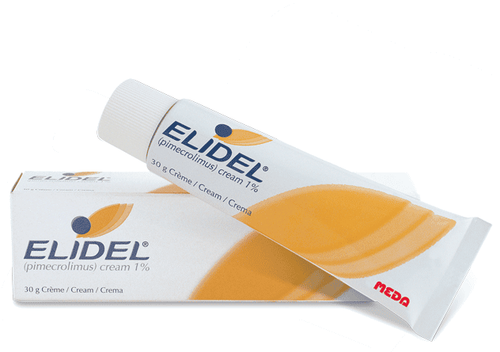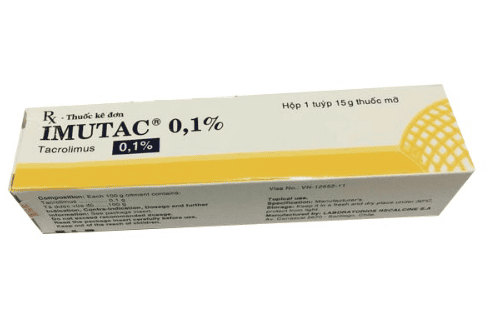This is an automatically translated article.
Tacropic 0.03 is manufactured and registered by Dat Vi Phu Pharmaceutical Joint Stock Company, belongs to the group of anti-cancer drugs and affects the immune system. Tacropic 0.03 can cause some side effects affecting the health of users, so it is necessary to use the drug exactly as prescribed by the doctor.
1. What is Tacropic?
Tacropic 0.03 has the main active ingredient, Tacrolimus 0.03%. The drug is prepared in the form of an ointment for topical application, packaged in a box of 1 tube of cream weighing 10g.2. Effects of Tacropic 0.03
Pharmacodynamics:
Nature Tacrolimus is a macrolide, with potent immunosuppressive effects similar to cyclosporin pharmacologically but structurally unrelated. The antibacterial activity of the drug is very limited. The improvement of skin lesions in patients with atopic dermatitis during treatment is associated with a reduction in the overstimulating effect on T lymphocytes and a decrease in the Fc receptor on Langerhans cells. . Tacropic 0.03 has no effect on human collagen synthesis. Pharmacokinetics:
Absorption: Single or repeated administration of Tacropic 0.03 has shown no or very little systemic effect. The bioavailability of Tacropic 0.03 ointment form is <0.5%. Blood concentrations are less than 1.0 mg/ml in the treatment of atopic dermatitis in adults and children with single or repeated doses of Tacrolimus 0.03 to 0.1% and in neonates > 5 months. age with the active ingredient Tacrolimus 0.03%. There is no evidence that there is accumulation of Tacropic 0.03 in patients on long-term treatment. Distribution: Tacropic 0.03 is mainly bound to plasma proteins with a rate of up to 98.8%, the amount of drug that has a very low systemic effect and has no clinical significance. Tacropic 0.03 has a selective effect on the skin and is poorly absorbed into the circulation. Metabolism: Tacropic 0.03 is not metabolized through the skin but in the liver and gastrointestinal tract. Elimination: In healthy subjects, in adults with liver and kidney transplants, the mean clearance after intravenous infusion of the active ingredient Tacrolimus was 0.04; 0.083 and 0.053 liters/hour/kg body weight. In patients with severe hepatic impairment, clearance is reduced. The mean elimination half-life of Tacrolimus was 65 hours in children and 75 hours in adults with repeated 0.03 doses of Tacropic.
3. Uses of Tacropic 0.03
Indications for drug use:
Tacropic 0.03 is used for children ≥ 2 years old, adolescents and adults. Tacropic 0.03 is indicated for short-term use in adults and adolescents 16 years of age or children 2 years of age for the treatment of moderate to severe atopic dermatitis in intolerant or unresponsive patients. adequate with other conventional therapies such as topical corticosteroids. For maintenance therapy, Tacropic 0.03 is used to prevent or prolong flare-ups in patients with moderate to severe atopic dermatitis with a high frequency of flares (in a year 4 times) and to prevent flare-ups. prevention of recurrence in patients who achieved an initial response after up to 6 weeks of treatment with Tacropic 0.03 twice daily. Contraindications to drug use:
Tacropic 0.03 is contraindicated in subjects with hypersensitivity to any component of the preparation, Tacrolimus, Macrolid or excipients.
4. Usage and dosage of Tacropic 0.03
How to use Tacropic 0.03:
Tacropic 0.03 can be used on any skin area of the body, except for the mucous membranes of the eyes, nose and mouth. When using only need to apply a thin layer on the skin, should not be covered, the skin should be dry. Keep Tacropic 0.03 from getting into your eyes, if it gets in, wash it off immediately with clean water. Short-term treatment dose:
In adults and adolescents 16 years of age and older: Start with Tacrolimus 0.1% twice a day, continue until the lesions disappear. If symptoms recur, tacrolimus 0.1% should be restarted twice daily. Efforts should be made to reduce the frequency of use or use Tacropic 0.03 (lower strength formulation) if clinical conditions permit. An improvement in symptoms can usually be seen after 1 week of treatment. If after 2 weeks there is no sign of improvement, it should be re-examined. No dose adjustment is required in elderly subjects. In children ≥ 2 years old, Tacropic 0.03 should be used twice daily for 3 weeks. Then reduce the frequency of use to once a day until the damage disappears. Maintenance therapy:
Used in patients who have responded to Tacrolimus twice daily for 6 weeks. In adults and adolescents 16 years of age and older: Use Tacrolimus 0.1% with a frequency of 2 days a week, once a day on the affected skin, each application should be spaced 2-3 days apart. If symptoms recur, treatment should be returned to a short-term regimen. Treatment for a maximum of 12 months, it is necessary to re-evaluate the condition to consider whether it should be continued. There is no dose adjustment in the elderly population. In children, the maintenance dose was similar to that of adults and tacropic 0.03 was used instead of Tacropic 0.1%.
5. Undesirable effects
Very common side effects when using Tacropic 0.03 such as:
The area of application is itchy and burning sensation. Common side effects include:
Local skin infection of any specific cause: folliculitis, severe Eczema, herpes virus infection, outbreak of Kaposil's Varicelliform, alcohol intolerance, confusion sensory disturbances and paresthesias, pruritus, redness, heat, pain, irritation, rash, and paresthesias. Less common side effects such as:
Acne. Other side effects when using Tacropic 0.03 with unknown frequency such as:
Herpes infections in the eyes; Turtle; Blushing; Edema, increased concentration of the drug. During the use of Tacropic 0.03, if you encounter any unwanted effects, it is recommended that the patient immediately notify the doctor for timely and effective treatment and treatment.
6. Pay attention to using Tacropic 0.03
During the use of Tacropic 0.03, patients need to avoid direct sunlight. Avoid applying the drug to a wound that is at risk of premalignancy or malignancy. Tacropic 0.03 is not recommended for use in patients with skin barrier defects: ichthyosis, Netherton's syndrome, systemic erythema, graft-versus-organ disease host in the skin. Caution is advised in organ transplant patients because of the possible increased risk of developing lymphoma and skin malignancies with prolonged use in combination with immunosuppressants. Caution should be exercised in patients with hepatic impairment, as Tacropic 0.03 is primarily eliminated by the liver. Do not use Tacropic 0.03 together with other topical preparations during treatment. Tacropic 0.03 should not be used by pregnant women, nursing mothers and children under 2 years of age. The drug does not affect the patient's ability to drive and use machines during the use of Tacropic 0.03. The article has provided information on what Tacropic is, dosage and precautions for use. To ensure safety for your health and maximize the effectiveness of your treatment, you need to take Tacropic 0.03 exactly as directed by your doctor.
Please dial HOTLINE for more information or register for an appointment HERE. Download MyVinmec app to make appointments faster and to manage your bookings easily.













